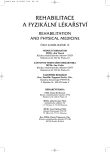EMG - Analysis of Selected Muscles of Upper Extremity Moving in Water Environment and Motion against Elastic Resistance
Authors:
D. Pavlů; D. Pánek
Authors‘ workplace:
Katedra fyzioterapie FTVS UK, Praha
vedoucí katedry doc. PaedDr. D. Pavlů, CSc.
Published in:
Rehabil. fyz. Lék., 15, 2008, No. 4, pp. 167-173.
Category:
Original Papers
Overview
The contribution refers to the importance of exploiting elastic bands and water environment for physiotherapy. The contribution is supplemented with a pilot study aimed to compare and document, using polyelectromyographic examination, the activity of selected muscles of shoulder girdle and the sequence of their engagement during abduction in the shoulder joint performed against the resistance of elastic band as well as against the resistance of water environment by means of the Auqafin remedy. The results indicate a different sequence of muscular activation during motion performed in water environment and outside of that and also, indicate the finding of lower muscular activity in movements outside the water environment. The results also suggest that in movements performed against the elastic resistance outside the water environment, the rapid myofilaments (muscle filaments) participate more than in movements in water environment. In contrast, the exercise in water will probably encounter prevailing activity of slow filaments, which also participate uniformly in the course of the whole recorded motion. The authors recommend a careful selection and establishment of the plan for using exercise in water environment.
Key words:
polyelectromyography, WaS-EMG, Water Surface EMG, shoulder girdle muscles, physiotherapy, elastic traction, water environment
Sources
1. ALBERTON, C., BLACK, G., VENDRUSCULO, A., BRENTANO, M., JUNIOR, N., KRUEL, L.: Muscle activation in water exercise: Agonist and antagonist action with or without resistive equipment. Port. J. Sport Sciences, 6, 2006, 6, Supl. 1, s. 71.
2. DECKER, M. J., HINTERMEISTER, R. A; KENNETH, J. F. et al.: Serratus anterior muscle activity during selected rehabilitation exercises. Am. J. Sports. Med., 27, 1999, 6, s. 784-791.
3. FRANCOVÁ, J., PAVLU, D., PÁNEK, D.: Měření elektrické aktivity vybraných stabilizátorů lopatky v polohách horní končetiny charakteristických pro sportovní lezení. Rehabil. fyz. Lék., 13, 2006, 1, s. 29-37.
4. HINTERMEISTER, R. A., LANGE, G. W., SCHULTHEIS, J. M., BEY, M. J., HAWKINS, R. J.: Electromyographic activity and applied load during shoulder rehabilitation exercises using elastic resistance. Am. J. Sports. Med., 26, 1998, 2, s. 210-220.
5. HUGHES, CH. J., McBRIDE, A.: The use of surface electromyography to determine muscle activation during Isoto- nic and elastic resistance exercises for shoulder rehabilitation. Orthop. Phys. Ther. Practice, 17, 2005, 2, s. 18-23.
6. KELLY, B. T., ROSKIN, L .A., KIRKENFALL, D. T., SPEER, K. P.: Shoulder muscle activation during aquatic and dry land exercises in nonimpaired subjects. J. Orthop. Sports. Phys. Ther., 30, 2000, 4, s. 204-210.
7. MASUMOTO, K., MERCER, J. A.: Biomechanics of human locomotion in water: an electomyographic analysis. Exerc. Sport. Sci. Rev., 36, 2008, 3, s. 160-169.
8. PAGE, P., ELLENBECKER, T. S. (Ed.): The scientific and clinical application of elastic resistance. Human Kinetics, Champaign, IL, 2003, 368, ISBN: 0-7360-3688-1.
9. PÁNEK, D., JURÁK, D., PAVLU, D., POKORNÁ, J., KRAJČA, V., ČEMUSOVÁ, J., POŽGAYOVÁ, Š.: Problematika snímání povrchového EMG ve vodním prostředí (Water Surface Electromyography – WaS-EMG). Lékař a technika, 2008, v tisku.
10. PAVLŮ, D.: Speciální fyzioterapeutické koncepty a metody I. 2. vydání. Brno, Cerm, 2004, 239 s. ISBN 80-7204-266-1.
11. PAVLŮ, D., PÁNEK D.: Electromyographic activity in stabilizers of shoulder blade by flex-bar Exercises. Presented on TRAC, Budapest 2007.
12. PAVLU D., PANEK D.: Analysis of EMG Activity in Stabilizers of Shoulder Blade by Holding of different „Soft Weights“. Presented on TRAC, Budapest, 2007.
13. PÖYHÖNEN, T., KYRÖlÄINEN, H., KESKINEN, K. L., HAUTALA, A., SAVOLAINEN, J., MÄLKIÄ, E.: Electromyographic and kinematic analysis of therapeutic knee exercises under water. Clin. Biomech., 16, 2001, 6, s. 496-504.
14. PÖYHÖNEN, T., SIPILÄ, S., LESKINEN, K. L., HAUTALA, A., SAYVOLAINEN, J., MÄLKIÄ, E.: Effect of Aquatic Resistance Training of Neuromuscular Performance in Healthy Women. Med. Sci. Sports. Exerc., 34, 2002, 12, s. 2103-2109.
15. RAINOLDI, A., CESCON, C., BOTTIN, A., CASALE, R., CARUSO, I.: Surface EMG alterations induced by underwater recording. J. of Electromyography and Kinesiology, 14, 2004, 3, s. 325-331.
Příspěvek vznikl s podporou VZ MŠMT ČR MSM 0021620864.
Labels
Physiotherapist, university degree Rehabilitation Sports medicineArticle was published in
Rehabilitation & Physical Medicine

2008 Issue 4
Most read in this issue
- Position-Related Vertigo Should not be Forgotten in Clinical Practice
- Survey of Present Opinions on the Problems of Hamstring Injuries in Sportsmen and Sportswomen
- Survey of Rehabilitation Methods in the Treatment of Urinary Incontinence Results of Foreign and Domestic Studies in Rehabilitation Therapy of Urinary Incontinence
- Effect of Musculus Levator Scapulae on Lordosis of Cervical Spine
